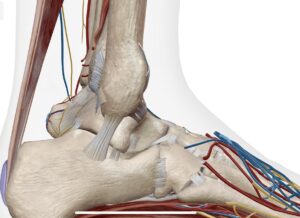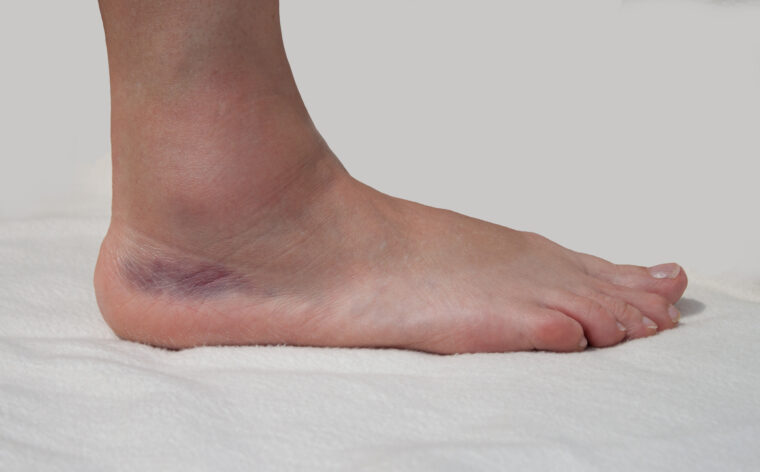Ankle sprains/strains happen…a lot. (We’ll have a YouTube chat about this soon as well as this blog here. Please subscribe to follow us.) That horrible feeling when you ‘roll your ankle in’. What exactly does this mean and what do we need to look for with ankle sprains?
The inversion ankle sprain is the most common of all ankle sprains, accounting for about 75-80%. The ankle can roll outward, but this is not too common. The medial side (inside) of your ankle tends to be more stable. This blog is about the most common form of ankle sprain, so let’s get going. (We’ll save the outward rolling ankle sprains and high ankle sprains for another discussion!)

The lateral ankle has the posterior talofibular ligament, the calcaneofibular ligament, and the anterior talofibular ligament.
The lateral (outside) ankle has several structures of importance. First, we have the bones. That lateral bump on your ankle is the lower most part of the fibula bone. Although the bone itself is not that important with weight bearing (under 20% by most sources), it is used to anchor a lot of muscles and ligaments. It mostly lends itself to ankle stability.
The bigger and more medial (inside) ankle bone is the tibia. It is weight bearing and this means that it does most of the work when you are walking and running around. Fractures of the ankle occur but not as often as soft tissue sprains (ligaments) and strains (muscles).
The lateral ankle has 3 primary ligaments of interest. It is usually one or more of these structures that gets injured when you roll your ankle inward. The posterior talofibular ligament is the one that is most far back on your ankle. We then have the calcaneofibular ligament (it goes up and down from the bottom of the fibula to the calcaneus bone). Finally, the anterior talofibular ligament. It is the most forward and usually most injured of the 3 ligaments.
Most commonly, ligaments get damaged when the muscles cannot support the structure. Should the ligaments fail, the bones tend to come next, and can break. Although not an absolute, this is what tends to happen.
We will now look at the muscles of the lateral ankle. The Peroneus (Fibularis) Longus and Brevis, which turn our ankle down and out, are on the backside of the leg/ankle. The Peroneus (Fibularis) Tertius, which is the outside most piece of the Extensor Digitorum, and which moves the ankle up and out, is a bit more anterior. The superior and inferior peroneal retinaculum, which are sheaths that house the peroneus longus and brevis tendons, are also of clinical importance.
When we turn our ankle in and as alluded to above, the muscles get pulled a lot (along with the superior and inferior retinaculum). If they cannot provide enough support, then the ligaments have to check the movement and they get over-stretched and can tear. If the ligaments lack integrity, then the bones take the brunt of the injury and this can lead to fractures.
Another important consideration is that with a first and/or more significant ankle sprain, the area will swell and inflame a lot. With each subsequent sprain, there tends to be less swelling. This is due to the fact that the tissues have been stretched out and no longer exhibit the same damage potential due to their inherent instability. This is the main reason why it’s so important to properly rehabilitate a sprained ankle.
We want properly functioning tissues to avoid progressive and cumulative damage. If not properly rehabilitated, with each subsequent sprain, the greater the damage will be and the higher the likelihood of fracture. In addition, we can develop a highly undesirable condition called Chronic Ankle Instability (CAI). For some, this is a condition that may never reach a full recovery.
There are many ways to recover from an ankle sprain. Initial intervention includes means to reduce inflammation and pain. We then work to get the damaged structures healthy. Once the tissues are healing, we work on reconditioning so the brain knows that they are working well. It’s one thing to have a physical recovery from damaged muscles and ligaments. It’s another for the brain to recognize that the tissues are healed and can take the load placed upon them by the particular sport you are participating in.
I hope this has been a good introduction to inversion ankle sprains. We’ll spend some time on YouTube going over this material and specific ways to address the injury. Thank you for allowing Don’t Be A Meathead help you and those you care about stay healthy and perform at a more optimal level.
Don’t Be a Meathead is protected by Copyright laws. If you wish to post any content from www.dontbeameathead.com, you must obtain express (written…this can be email) permission before doing so. We love sharing important information to help people and we do appreciate your respect for our intellectual property.





